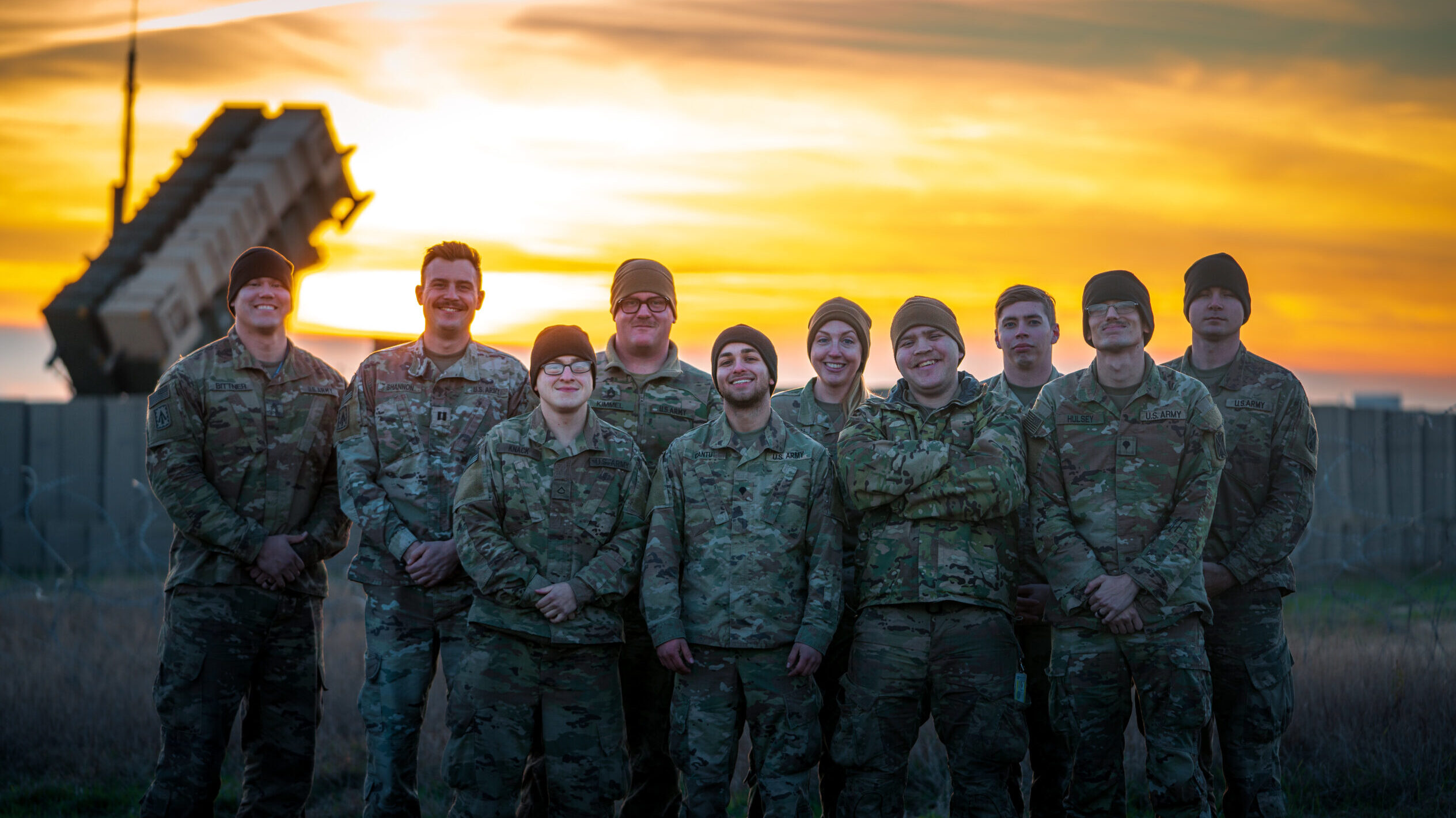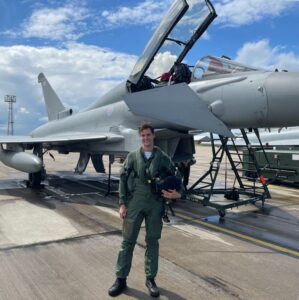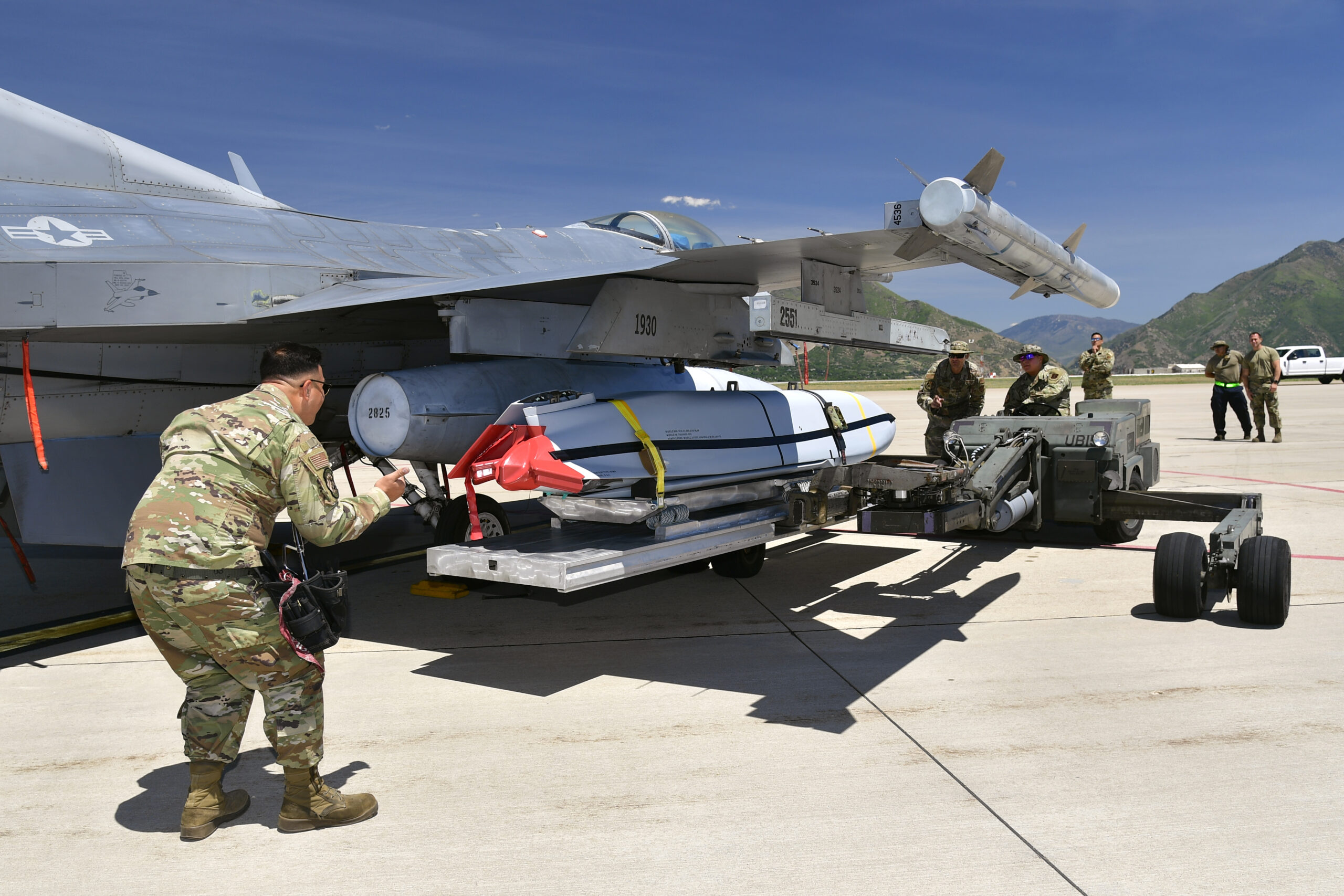
Members of Charlie Battery, 5th Battalion, 7th Air Defense Artillery pose with one of their Patriot missile launchers in Poland in late 2022. Photo courtesy of US Air Force.
In this Q&A with Justin Bronk, senior research fellow for Airpower and Technology on the Military Sciences team at the Royal United Services Institute (RUSI), a London-based defense and security think tank, we discuss: a scenario when China and Russia simultaneously present challenges designed to break NATO’s Article 5; the state of European air forces in terms of future production and fleet mixture in light of Ukraine; and how the air chiefs see all-domain operations.
Breaking Defense: The threat to Ukraine is clear, but what are the threats to NATO countries? The nuclear threat has always been there, so what’s changed?
Bronk: There are two different categories. There is the inadvertent escalation threat, which is essentially nuclear. Even though neither side wants the conflict, somebody does something stupid, it escalates, we don’t find a way out of it and everything ends up nuclear, because Russia has no capacity to fight NATO conventionally, at least for now.
As long as Ukraine continues as an active conflict, Russia probably does not have the capacity to pose a conventional threat to Europe. That’s the inadvertent nuclear escalation threat.
The longer term, more serious threat for NATO is the three-to-five-year outlook with Russia. As the ongoing high-intensity conflict shakes out — whether Ukraine does extremely well in the upcoming offensive and takes back lots or even all of its territory, or if they don’t take back nearly that much or they take back some but ultimately they run out of steam — the outlook from the end of this year onwards is probably a frozen conflict one way or the other.
The problem for NATO in that context — the threat that I see that we need to be ready for — is in the three-to-five-year context. The war in Ukraine in its current form probably can’t last that long in active phase because both sides will exhaust too much of their manpower and ammunition stocks. Maybe [that’s not the case], but we’d have to have a total transformation of the industrial base for military production to support that.
Once there is some form of either essentially frozen conflict or even a Ukrainian victory, it’s unlikely that we will see Russia stop mobilizing and stop trying to recruit and retrain large numbers of new troops. Even in the scenario where Ukraine has won and the war is uneasily over, they will still feel very vulnerable. They will still feel like they’ve degraded a huge amount of their conventional military both in terms of its actual potential and its perceived potential. They will have a huge incentive to keep trying to generate a much larger standing military.

Justin Bronk is senior research fellow for Airpower and Technology on the Military Sciences team at RUSI, Royal United Services Institute.
They’ve put their industry on a war footing, or at least they’re trying to as of the back end of 2022. They’re very unlikely to go back on that either. Particularly once the shooting stops, or at least pauses for a time, China is more likely to feel able politically to openly enable them to re-arm, because China at the geostrategic level requires Russia to still pose a credible military threat in Europe to tie down at least European and ideally American military forces in Europe.
The danger is — if something happens in the Indo-Pacific, either over Taiwan, on the Korean peninsula, the South China Sea, any of these potential flashpoints — you have either an active conflict or a very serious military standoff between the US and its allies and China.
That is exactly when you would expect Russia to have its best chance, and therefore most opportunity and motivation to try and reestablish conventional deterrence against NATO by a short, sharp win, as well as break Article 5 [that calls for collective defense], which has always been their key foreign policy [goal] so that they can go back to dealing with their neighbors on a bilateral basis where Russia is big and the neighbors are small — almost back to that old Baltic scenario where the Russians don’t need to try and invade large portions of the country.
All they need to do to break NATO is to demonstrate that Article 5 is a bluff. If I were them, I would take a very small, insignificant strip of marshy forest somewhere on the border, put a couple corps of armored troops behind it and loads of air defense and say, “We’re not going any further” and insert [BS] justification.
Breaking Defense: Claims like ‘We’re protecting Russian speakers here in the area.’
Bronk: Exactly, but to do so when America is fully occupied in the Indo-Pacific. That to me is the big threat. Because not only does Russia have every incentive to do that from the perspective of a lot of the Russian security apparatus, but also China would have a strong incentive to try and push Russia to do that because they will need to divert American attention, they will need to keep European forces in Europe, they will need to basically take away the US ability to concentrate its own allied support in the Indo-Pacific.
People often ask, ‘What is the threat? Is the next big one Russia or China?’ My worry is it’s both. It’s a concurrent crisis in Europe because something has started in the Indo-Pacific. That’s where Europeans are going to have to be able to carry their own weight.
That basically requires being able to roll back the IADs. If we can roll back the integrated air defense system, then the Russian army does not pose a threat. NATO has enough tac air that that’s just not a problem if we can roll back the IADs. If NATO in Europe has that credible capability, the Russians probably won’t try. If we don’t, and currently we don’t without the US doing most of the heavy lifting, that’s much more of a problem.

Airmen with the Air National Guard Air Force Reserve Command Test Center load a Joint Air-to-Surface Standoff Missile (JASSM) on a pre-block F-16 for a test launch in mid-2022. This is the first time a JASSM has been launched from a pre-block F-16, a model flown by Air National Guard and Air Force Reserve units, and could potentially be flown by Ukrainian pilots. Photo courtesy of US Air Force.
Breaking Defense: How would you describe the present state of European air forces compared to the day before Russia’s attack on Ukraine? I don’t necessarily mean in aircraft production but in how priorities have changed for future production, fleet mixture.
Bronk: You’re seeing a real split in Europe. Some countries are clearly changing their combat air procurement to specifically try and address the gaps in European ability to deter and if necessary defeat, because that’s what you need to be able to do to deter Russia in the three-to-five-year timeframe.
Those are the countries you see that are recommitting or committing newly to large numbers of F-35, or increasing their F-35 buys, and that are spending large amounts of money to order lots of standoff munitions: JASSM, JASSM-ER, AGM SLAM-ER, SPEAR 3.
In other words, they’re buying equipment that is expensive but is specifically designed to either do that SEAD/DEAD Suppression and Destruction of Enemy Air Defenses role, the destruction being the key bit, or at least to be able to operate credibly in the absence of that task being fully completed.
On the other hand, you see countries where the procurement dynamics really haven’t shifted, where, yes, there might be some attempts to plus-up procurements for a few munitions types, but broadly the focus still remains on the next generation of systems, whether that be SCAF [Système de combat aérien du futur] or Tempest GCAP [Global Combat Air Programme], which even with the best will in the world will not be available until the late 2030s at the earliest, and therefore don’t actually help with plugging any of those gaps for the next decade.
Indeed, in many cases actually hinder it because the investment that you need to put in upfront to get the ball rolling for the R&D and the initial production orders for those next-generation platforms is competing directly with the money that you would need to plus up what we currently have in order to plug the gaps.
You also see one or two examples of countries finally taking delivery of platforms that are great for supporting special forces in permissive counterinsurgency air environments, just as we’ve all stopped doing that.
Breaking Defense: Staying on the subject of deterrence, I’m hearing from some in industry — because they’re getting tasked with this — that the new definition of deterrence is replenishing American stockpiles and simultaneously having the ability to keep arming Ukraine in a high-intensity war, while at the same time developing the next generation of weaponry like hypersonics.
Bronk: Who is best at deterrence in Europe? Finland. What does Finland have? It can mobilize 270,000 troops in a week and exercises it, and has ammunition reserves for 1,000 artillery guns plus for six months of high intensity combat. They understand deterrence.
Breaking Defense: And Russia knows that.
Bronk: They understand it happens in the Russian mind because that’s who you’re deterring. So what do the Russians count? Well, they count guns, they count stores, they count tanks. Now, we might think of that as terribly outdated, but deterrence happens in their mind, not in ours.
Breaking Defense: What’s the European view of the conflict in the Indo-Pacific? Is it viewed as mainly an American/Australian problem?
Bronk: For the US, it’s the Indo-Pacific. The threat and the demand signal that they’re looking at there is just overwhelming at the moment with the resources at hand. In the US, that is driving everything increasingly in terms of whether that be current ops tempo, exercise, scheduling, threat scenarios, and certainly forward investment.
Part of that is a political demand signal that says essentially the rest of NATO needs to do more to lock down Europe if things go off in the Indo-Pacific. Because, quite frankly, even if we had forces available, if the Americans are overmatched in time and space in large parts of the Pacific, then Europeans certainly are, especially if they’re trying to project from Europe.
For example, what’s the most effective way Europe can contribute to an effective carrier battle group in the Indo-Pacific theater? It’s not by putting the Charles De Gaulle or the Queen Elizabeth there, it’s by putting the Charles De Gaulle or the Queen Elizabeth in the Eastern Med or the Gulf so that the American carrier group there can go off to the Indo-Pacific.
In terms of what I hear behind the scenes, essentially the American demand signal is: ‘Europe, you have to stand up and be able to backfill your own backyard so that we can handle the threat in the Indo-Pacific.’ And if you’ve got excess capacity after you do that, then great, by all means come out and help us in the Indo-Pacific.
I think there’s a frustration internally about the public, continued insistence from a lot of European countries of trying to send tiny force packages with huge logistical burdens to the Indo-Pacific as a, quote-unquote, warfighting capability.
There’s a huge amount of good political and diplomatic efforts that the European NATO nations can contribute to the Indo-Pacific, but in terms of warfighting capacity I think there’s a bit of US frustration there.
Breaking Defense: JADC2 for multi-domain operations and interoperability are top of mind right now in the US. How is MDO, which is known as Multi Domain Integration in the UK MoD, viewed in Europe?
Bronk: I think there’s two main overarching differences between the US and European NATO, and I’d include Canada as non-US NATO. In terms of multi-domain operations, the first difference is that the US is planning to deter. To deter it must be credibly capable of winning a war with China with capabilities and at a scale that other NATO members just don’t have and don’t face. The imperative from the American side is much more pressing and also much better defined.
The second main difference, apart from money, is that the US has vast amounts of actual real credible kinetic conventional military capability. Joining it all up, or as much of it as you can, in such a way as to make more efficient use of all the different sensors and shooters across all the domains in real time, promises a massive increase in overall capability. Because you’re essentially multiplying an enormous force and increasing its effectiveness, the return is huge.
Whereas a lot of European countries are essentially engaging with discussions, investments, and research in multi-domain operations in the hope that by doing these things on a small scale, they will somehow create capability from effectively nothing. In other words, they risk generating the enabling function without any force to enable.
Ultimately, you can have the best-connected company of soldiers and two jets in the world, and they might be phenomenally effective until they run out of ammunition, but they’re not going to amount to much.
I think that the risk for Europe is that they invest in and talk about multi-domain operations and those enabling cross-domain C2 and networking architectures as a way to avoid talking about the fact that they just don’t have enough ammo, planes, tanks, troops, bases, air defense.




















